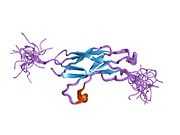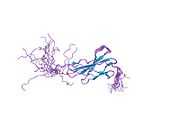BOC (gene)
| BOC cell adhesion associated, oncogene regulated | |||||||||||||
|---|---|---|---|---|---|---|---|---|---|---|---|---|---|
 PDB rendering based on 1x4y. | |||||||||||||
| |||||||||||||
| Identifiers | |||||||||||||
| Symbols | BOC ; CDON2 | ||||||||||||
| External IDs | OMIM: 608708 MGI: 2151153 HomoloGene: 32819 GeneCards: BOC Gene | ||||||||||||
| |||||||||||||
| Orthologs | |||||||||||||
| Species | Human | Mouse | |||||||||||
| Entrez | 91653 | 117606 | |||||||||||
| Ensembl | ENSG00000144857 | ENSMUSG00000022687 | |||||||||||
| UniProt | Q9BWV1 | Q6AZB0 | |||||||||||
| RefSeq (mRNA) | NM_033254 | NM_172506 | |||||||||||
| RefSeq (protein) | NP_150279 | NP_766094 | |||||||||||
| Location (UCSC) | Chr 3: 112.93 – 113.01 Mb | Chr 16: 44.49 – 44.56 Mb | |||||||||||
| PubMed search | |||||||||||||
Brother of CDO is a protein that in humans is encoded by the BOC gene.[1][2]
CDON (MIM 608707) and BOC are cell surface receptors of the immunoglobulin (Ig)/fibronectin type III (FNIII; see MIM 135600) repeat family involved in myogenic differentiation. CDON and BOC are coexpressed during development, form complexes with each other in a cis fashion, and are related to each other in their ectodomains, but each has a unique long cytoplasmic tail.[supplied by OMIM][2]
Interactions
BOC (gene) has been shown to interact with CDON.[1]
References
- ↑ 1.0 1.1 Kang JS, Mulieri PJ, Hu Y, Taliana L, Krauss RS (Jan 2002). "BOC, an Ig superfamily member, associates with CDO to positively regulate myogenic differentiation". EMBO J 21 (1-2): 114–24. doi:10.1093/emboj/21.1.114. PMC 125805. PMID 11782431.
- ↑ 2.0 2.1 "Entrez Gene: BOC Boc homolog (mouse)".
Further reading
- Bonaldo MF, Lennon G, Soares MB (1997). "Normalization and subtraction: two approaches to facilitate gene discovery.". Genome Res. 6 (9): 791–806. doi:10.1101/gr.6.9.791. PMID 8889548.
- Strausberg RL, Feingold EA, Grouse LH et al. (2003). "Generation and initial analysis of more than 15,000 full-length human and mouse cDNA sequences.". Proc. Natl. Acad. Sci. U.S.A. 99 (26): 16899–903. doi:10.1073/pnas.242603899. PMC 139241. PMID 12477932.
- Kang JS, Feinleib JL, Knox S et al. (2003). "Promyogenic members of the Ig and cadherin families associate to positively regulate differentiation.". Proc. Natl. Acad. Sci. U.S.A. 100 (7): 3989–94. doi:10.1073/pnas.0736565100. PMC 153035. PMID 12634428.
- Wegorzewska M, Krauss RS, Kang JS (2003). "Overexpression of the immunoglobulin superfamily members CDO and BOC enhances differentiation of the human rhabdomyosarcoma cell line RD.". Mol. Carcinog. 37 (1): 1–4. doi:10.1002/mc.10121. PMID 12720294.
- Clark HF, Gurney AL, Abaya E et al. (2003). "The secreted protein discovery initiative (SPDI), a large-scale effort to identify novel human secreted and transmembrane proteins: a bioinformatics assessment.". Genome Res. 13 (10): 2265–70. doi:10.1101/gr.1293003. PMC 403697. PMID 12975309.
- Ota T, Suzuki Y, Nishikawa T et al. (2004). "Complete sequencing and characterization of 21,243 full-length human cDNAs.". Nat. Genet. 36 (1): 40–5. doi:10.1038/ng1285. PMID 14702039.
- Kang JS, Yi MJ, Zhang W et al. (2004). "Netrins and neogenin promote myotube formation.". J. Cell Biol. 167 (3): 493–504. doi:10.1083/jcb.200405039. PMC 2172498. PMID 15520228.
- Tenzen T, Allen BL, Cole F et al. (2006). "The cell surface membrane proteins Cdo and Boc are components and targets of the Hedgehog signaling pathway and feedback network in mice.". Dev. Cell 10 (5): 647–56. doi:10.1016/j.devcel.2006.04.004. PMID 16647304.
| |||||||||||

